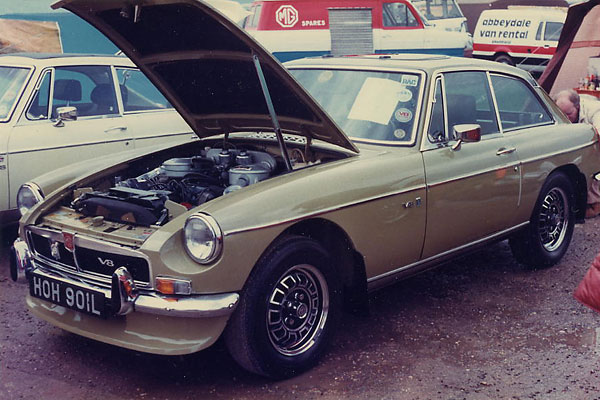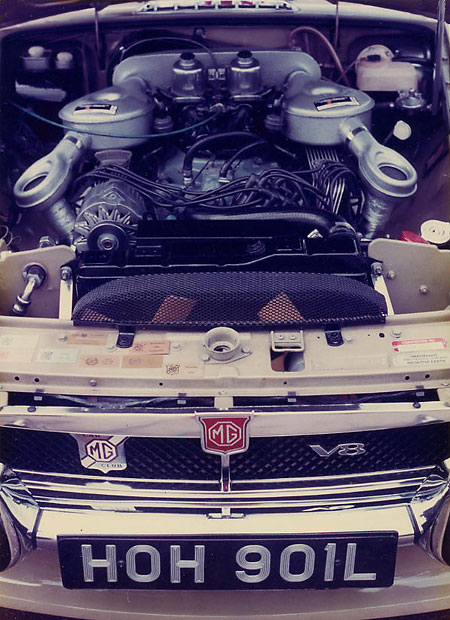
Not to be published until Wednesday 15th August 1973
MGB GT V8
DESCRIPTION OF THE CAR
Introduced in 1965, the MGB fastback coupe, with its third door offering access
to the rear interior of the body, has a compact, robust and stiff unitary
structure. It is now offered in 3.5 litre V8 form as an option to the well proved
1.8 litre B-series four cylinder engined version. Both these cars share rack and
pinion steering, coil spring and unequal length wishbone independent front
suspension, and a beam rear axle on half elliptic leaf springs, strengthened in
the V8 to cope with almost double torque and power output.
The body structure meets worldwide regulations for safety and survival in accidents,
while padded fascias, safety switches, anti-burst locks, lights and other fittings
meet both U.S. Federal and European Economic Community regulations. The steering
wheel is fully padded.
Equipment is complete and includes a concise complement of clear instruments, deep
bucket seats and a large carpeted area at the rear capable of accommodating small
children or a great deal of luggage. The big tail door swings high to give easy
access to this area.
3.5 LITRE ENGINE
Similar in many ways to the lightweight 3.5 litre unit installed by Rover 3500S and
3500 since 1968, the V8 engine is tailored to the MGB GT installation by converting
the penthouse carburetter manifold to one in which the carburetters are mounted at
the rear of the engine. The other major change is to an AC Delco alternator. Free
flow exhaust are also specified.
Light alloy for the stiff block and for the heads make the basic V8 some 40 lbs
lighter than the 1.8 litre four cylinder, which continues in the type, but with the
inevitable complexity and weight of the ancillary equipment now essential to meet
noise, emission and safety regulations, the total weight goes up to a little more
than that of the 1.8 litre unit. Most of the extra weight is on the front wheels,
the ratio from front to rear being 49.4/50.6% compared with the 47.8/52.2% of the
four cylinder.
The SU HIF 6 (horizontal integral float chamber) carburetters provide stable
carburetion under all conditions of hard cornering, acceleration and braking. They
are installed at the rear of the engine on a specially designed low-line manifold
evolved by the long-time tuning wizards at MG to give dual benefits of greatly
reduced temperature scatter from one cylinder to another, compared with the original
penthouse manifold, and at the same time to make it possible to avoid the need for
a 'power bulge' on the smooth contours of the bonnet. Neat bi-metallic valves are
arranged to draw in warm air for the carburetters from sleeves on the exhaust
manifolds, then to take in cooler air when the engine is warm.
The short-stroke, big bore engine has five crankshaft bearings and the inclined
overhead valves are actuated by hydraulic lifters and rockers from the central
camshaft. The compression ratio is 8.25:1, maximum bhp (DIN) is 137 at 5,000 rpm;
torque is 193 lb ft at 2,900 rpm.
MECHANICAL REFINEMENT
Detail modifications have been carried out to the all-synchromesh C-type gearbox,
transmission and rear axle. The gearbox casing has been redesigned to accept a
larger clutch to match the substantial power increase of the V8 engine. As the
torque is almost doubled compared with the four cylinder version, the intermediate
gear ratios have been raised to meet the different output curve as well as to reduce
the torque load into the box. The axle ratio is 3.07:1 as against 3.91:1 of the
1.8 litre version.
The clutch withdrawal race is now a ballrace instead of the more customary carbon
bush, a design refinement initially found on the British Leyland transverse engine
Maxi range.
Installing the larger engine, which fully fills the engine bay, meant changes to
the bulkhead and slight modifications to the inner wheel arches to clear the exhaust
manifolds. There was a minor modification to the front crossmember to make space
for ancillaries.
To control the greatly increased torque, the rear half elliptic springs are
substantially stiffer and heavier coil springs are specified at the front. The dampers
are unchanged.
STRONGEST WHEELS
New Dunlop 5J wheels with ventilated cast alloy centres riveted to chromed steel rims are fitted with 175 HR x 14 tyres. The Abingdon engineers believe these are the strongest wheels they have ever fitted. In the laboratory rig testing, up to 600,000 load reversals were required. In this case the batch was taken off after 3 million reversals and a single wheel, kept on for interest's sake, was still going strong at six million load reversals.
QUIET COOLING
There is a larger radiator, equipped with two thermostatically controlled electric
fans to reduce fan noise and power absorption. An oil radiator is also provided.
From the driver's seat the view is much the same as on the smaller engined version,
except that on right hand drive models sold in the United Kingdom, 80mm speedometers
and tachometers replace the four inch instruments normally installed. A collapsible
steering column, adopted in the interests of greater safety is the reason for the
difference.
FULLY EQUIPPED
Features to be specified as standard on the MGB GT V8 will include overdrive on
top gear, brake servo, cast alloy special wheels, door mounted mirror, tinted
window glasses, and the electrically operated cooling fans.
(b)
Enjoying this article? Our magazine is funded through the generous support of readers like you!
To contribute to our operating budget, please click here and follow the instructions.
(Suggested contribution is twenty bucks per year. Feel free to give more!)
At the British V8 Newsletter, we don't currently have access to the photo negatives,
proofs, or artist renderings that probably accompanied the original text of the
MGB GT V8 press release. We can only speculate on what sort of photography might
have been included. Two selections are included below.
The 1973 MGB GT V8 that carries license plate "HOH 901L" (series number 0118)
belongs to Mike Dunlop, but we understand that originally this car was used as
one of the main press demonstration and photography vehicles. (Our two photographs
of it, shown here, date from July 1983 and were taken by Ken Smith at a "V8
Register" meet.) One thing that's interesting and unusual about this car is its
paint color: "Limeflower" (not the more popular and widely known "Harvest Gold").
It does show up great in photos!


Disclaimer: The last two paragraphs were written by Curtis Jacobson. Views expressed are those of the author, and are provided without warrantee or guarantee. Apply at your own risk.
This article is part of a set of FIVE! If you enjoyed this article, check out:
MGB GT V8 Press Release - Introduction
MGB GT V8 Press Release - "Development of the Body and the Engine"
MGB GT V8 Press Release - "Grandest Tourer - Latest of a Line"
MGB GT V8 Press Release - "Technical Specifications"
BritishV8 Magazine has assembled the largest, most authoritative collection of MG "MGB GT V8" information you'll find anywhere. Check it out! Access our MGB GT V8 article index by clicking here.


